Optics Performance
The Orion SpaceProbe 130ST is a 130mm f/5 Newtonian, optically identical to other 130mm f/5 Newtonians such as Zhumell Z130, Sky-Watcher Heritage 130p, and Celestron 130SLT/Astro-Fi 130.
Since it has a focal ratio of f/5, this scope delivers nice wide-field views, albeit with a little coma. However, I wouldn’t worry much about the coma.
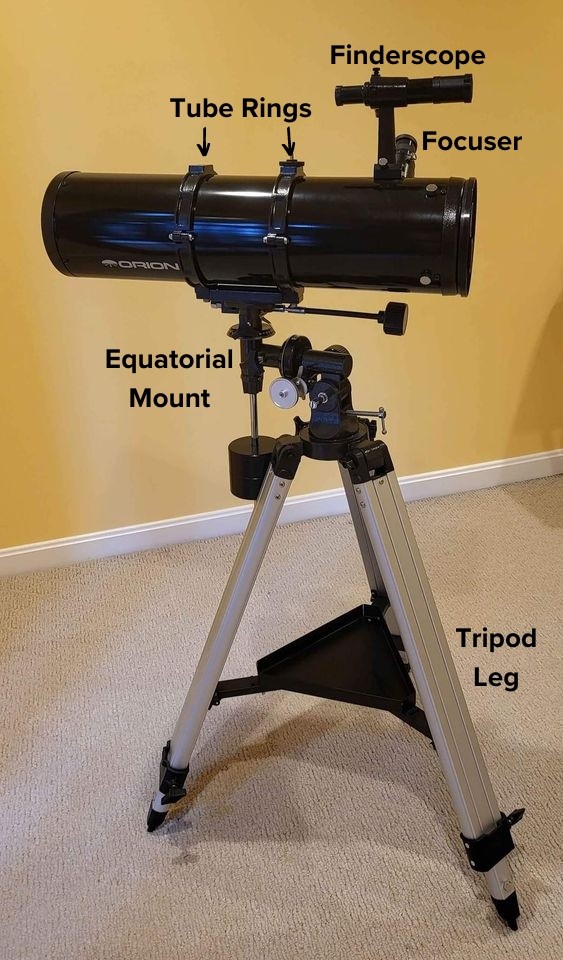
It has a 1.25” rack-and-pinion focuser, which is made mostly out of plastic. But I found it to be working pretty well.
The 130ST attaches to its mount with a pair of tube rings but no Vixen dovetail system. To put it on another mount, we’d need to buy a dovetail and attach it to the rings.
Optics’ Collimation Requirements
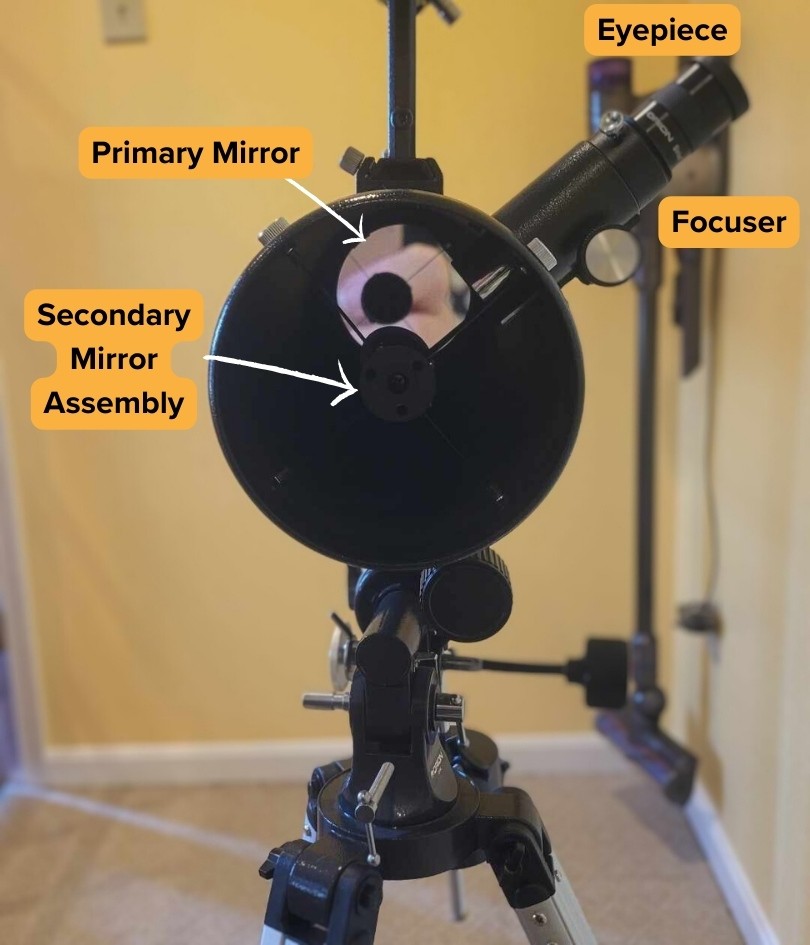
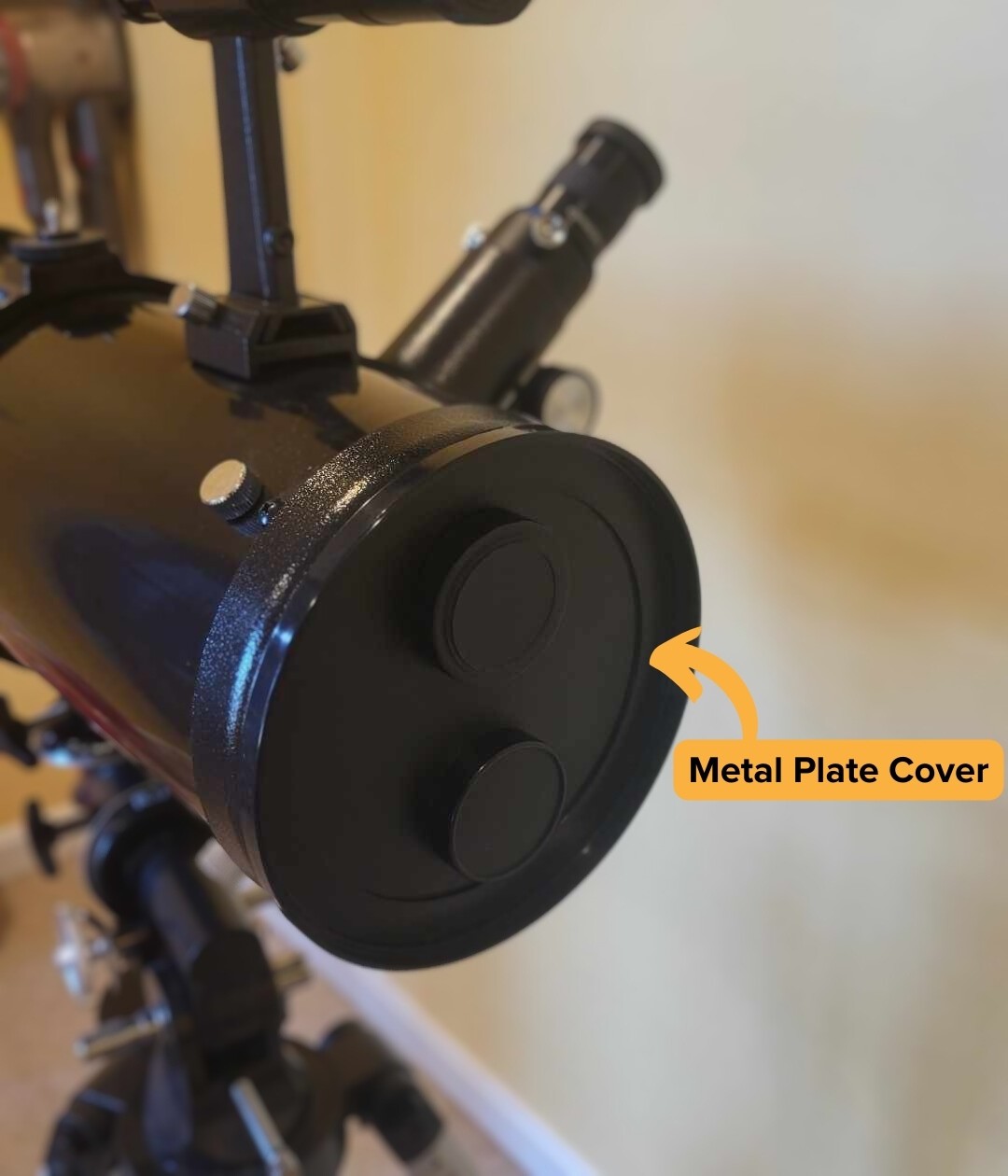
The primary mirror is made of plate glass, and both the primary and secondary mirrors are, of course, collimatable.
For whatever reason, Orion has covered the back of the primary mirror cell with a useless metal plate, as you can see in the above photo, obscuring the collimation screws and hindering the telescope’s cooldown when taken from indoor storage to outdoors. I’d remove the plate with a Phillips head screwdriver if I were you.
Collimating the scope’s primary mirror requires a screwdriver, which can be rather frustrating in the field.
The Accessories
The SpaceProbe 130ST includes 1.25” 25mm (26x), and 10mm Plossl (65x) eyepieces. These Plossls are better than the cheap Kellners/Modified Achromats supplied with cheaper telescopes.
The newer version of the SpaceProbe 130ST replaces the old 6×30 magnifying finderscope with a red dot sight finderscope, which projects a red dot onto a window through which we view the sky. After aligning the red dot finder with our telescope, we just need to aim the red dot at our target, and if aligned correctly, we should have the target in the field of view of the telescope’s eyepiece. A red dot finder works well for aiming a telescope of this aperture and focal length, though aiming a scope on an equatorial mount manually is, of course, still a bit cumbersome.
A collimation cap is also included, though a Cheshire collimator or laser is ideal. Read our guide to learn more.
About the Mount Capabilities
The SpaceProbe 130ST comes on a standard, cheap German equatorial mount, this one being an EQ2.
The EQ2 is up to the task of holding the 130ST. But is not the steadiest mount available for such a scope, particularly if I extend the tripod legs to a comfortable height.
Unlike with more expensive scopes/mounts, the 130ST’s tube rings simply bolt to the EQ2 rather than using a Vixen dovetail and saddle.
The primary advantage of an equatorial mount is that tracking the sky is much simpler than with an alt-az mounted scope. We simply turn the RA slow-motion cable occasionally or install a motor drive.
One can purchase a motor drive for hands-free tracking from Celestron or Orion, which will work fairly well for visual use but simply isn’t up to par accuracy-wise for astrophotography. The drive makes high-power viewing nice, but hand-tracking at even 250x really isn’t a problem for me with the mount’s slow-motion cables.
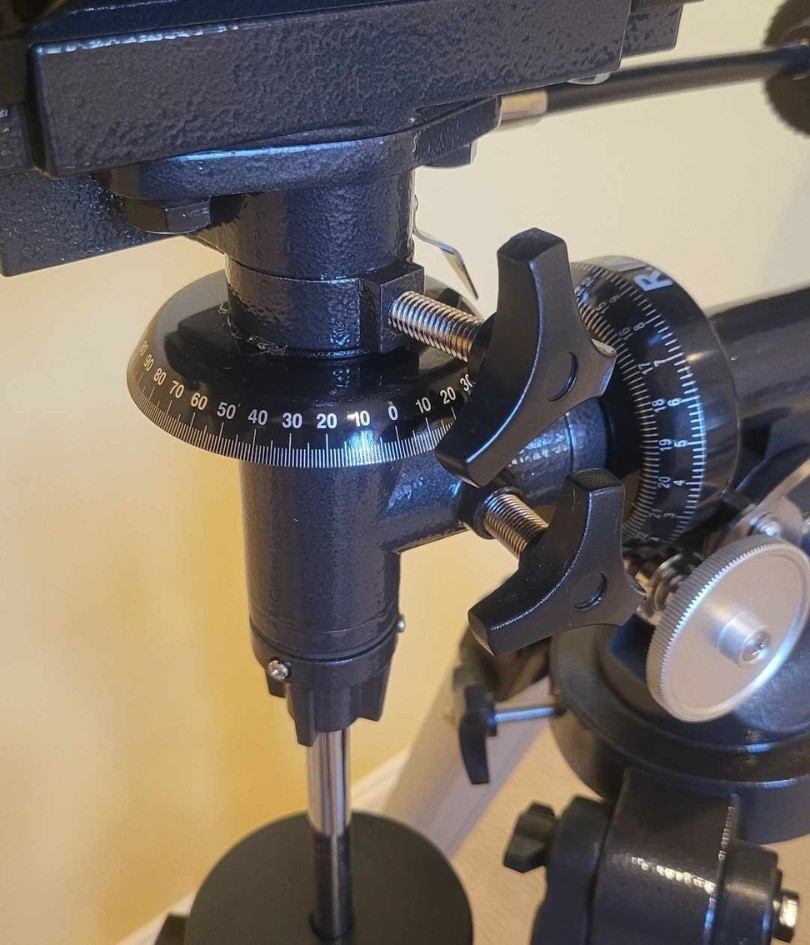
The setting circles on the EQ2 are way too small and inaccurate to be useful for much of anything and are purely decorative, as on most modern equatorial mounts.
The mount lacks a polar scope or sighting hole, so precise polar alignment is difficult. For visual use, this isn’t a huge concern. But for photography, it’s a problem.
Should I buy a used SpaceProbe 130ST?
The SpaceProbe 130ST is quite a nice scope, and my main criticism of it is that it is not such great value if bought new. If you can get a deal on a used one, by all means, go for it.
Alternative Recommendations
For the price of the SpaceProbe 130ST or a little more, you could get a higher-quality and/or larger telescope with a simpler and steadier mount. But if you’re adamant about a reflector mounted on a tripod mount, the SpaceProbe 130ST would be the best fit for the price.
Under $350
- Manual Dobsonian Scope: The Sky-Watcher Heritage 150P is slightly larger in aperture than the SpaceProbe 130ST, while its tabletop Dobsonian mount and collapsible tube make setup and aiming a breeze, as well as a very compact package when collapsed.
- Manual Dobsonian Scope: The Zhumell Z130 and Sky-Watcher Heritage 130P are more or less the same telescope as the 130ST but mounted atop a less costly and simpler tabletop Dobsonian mount. They also feature red dot finders, which are arguably easier to use. The 130P’s tube collapses as well, which increases the portability factor even further.
$350-$550
- Computerized Dobsonian Scope: The Sky-Watcher Virtuoso GTi 150P offers the same larger aperture and portable form factor as the Sky-Watcher Heritage 150P and is identical optically, but adds fully motorized GoTo and tracking capabilities. A 130mm model, the Virtuoso GTi 130P, is also available and makes for a great choice.
- Manual Dobsonian Scope: The Apertura AD6 offers a full-sized Dobsonian base that doesn’t need to be set on a table or tripod, with easy-to-collimate f/6 optics and a high-quality 2” dual-speed Crayford focuser built in. A 6” Dobsonian will offer a bit more aperture and a much simpler and quicker-to-setup mount than the 130ST’s equatorial mount and tripod. For a bit more money, you could also go for an 8” model, which is basically the same physical size.
- Manual Refractor: The Celestron Omni XLT 102AZ offers similar performance to the SpaceProbe 130ST, but its refractor optics don’t need collimation, though the chromatic aberration interferes with sharp, high-power views. Its alt-azimuth mount is also easier to use than the SpacProbe 130ST’s equatorial mount.
Aftermarket Accessory Recommendations
The 130ST’s 650mm focal length means that even the “high magnification” 10mm Plossl provides only 65x. Even under poor seeing conditions, the 130ST can take 100x, and up to 250x is possible on good nights with good collimation. For optimal views of the Moon and planets and to split close double stars, I’d recommend using between 100-175x.
A 6mm “goldline” will give you 108x, or you could buy a 2x Barlow lens to get 130x with the 10mm Plossl and a moderate magnification of 52x with the 25mm Plossl that comes with the 130ST. An Astromania 4mm Planetary will provide 163x, which is getting closer to the upper limit of magnification that the 130ST can handle on most nights.
The 130ST’s equatorial mount has an attachment for a motor drive. You could get Orion’s dual-axis EQ-2M drive and have push-button slow-motion adjustments on the RA axis, or opt for the more simple Celestron Logic Drive which just tracks the sky with no other functions.
What All Have I Seen and Can See
The SpaceProbe 130ST does a fairly good job on the Moon and planets, at least if you purchase an additional eyepiece or Barlow. 65x, the maximum magnification possible with the stock eyepieces, isn’t exactly going to make viewing small details on them easy.
- On a night of good seeing, I was able to see Jupiter’s cloud belts, the Great Red Spot, and even the shadow transits of its moons.
- Saturn’s rings, the Cassini division within them, some cloud belts, and a handful of moons can also be seen.
- Venus and Mercury will show their phases, while Mars reveals a few dark spots and its polar ice cap.
- The Moon is great, as always.
- Uranus and Neptune are little more than star-like points if you can manage to locate them in the first place.
The 130ST’s 650mm focal length gives it a relatively wide field of view at low magnifications, making it great for viewing big and bright deep-sky objects like the Pleiades, Andromeda Galaxy, and so forth.
I could see hundreds of beautiful open star clusters, details in a few dozen galaxies (under dark skies only—under urban or suburban viewing conditions, most galaxies are little more than smudges), and jaw-dropping details in nebulae like Orion and the Swan. I could also just begin to resolve bright globular clusters like M13 and M22 into individual stars on a good night. Planetary nebulae like the Cat’s Eye begin to show colors and even detail at moderate magnifications.
Astrophotography Capabilities of SpaceProbe 130ST
So, what can you really do, astrophotography-wise, with the SpaceProbe 130ST?
A DSLR camera is too much for the focuser and mount to handle, so deep-sky astrophotography is basically out of the question. In any case, autoguiders and the like would be needed for good pictures, and the SpaceProbe cannot accommodate these things.
We’re limited to the Moon and planets, using a webcam-style CCD like a Celestron NexImage or ZWO ASI camera.
In addition to the power and laptop requirements, we’ll need a 3x or 5x Barlow lens to get the SpaceProbe to an optimal focal length. Barlows this strong are too much for visual use, but the optimal focal ratio for planetary imaging is f/15 to f/25.
In addition, the mount needs to be aligned accurately to keep tracking accurate enough to keep whatever we’re imaging in the tiny field of view of the camera, which is hard when there’s no polar scope or sighting hole, as I mentioned previously.
All in all, while planetary astrophotography can be done with the SpaceProbe 130ST, we’ll be spending more than the scope costs to do so, and we’ll be severely limited by its inexpensive mount and 5” aperture.

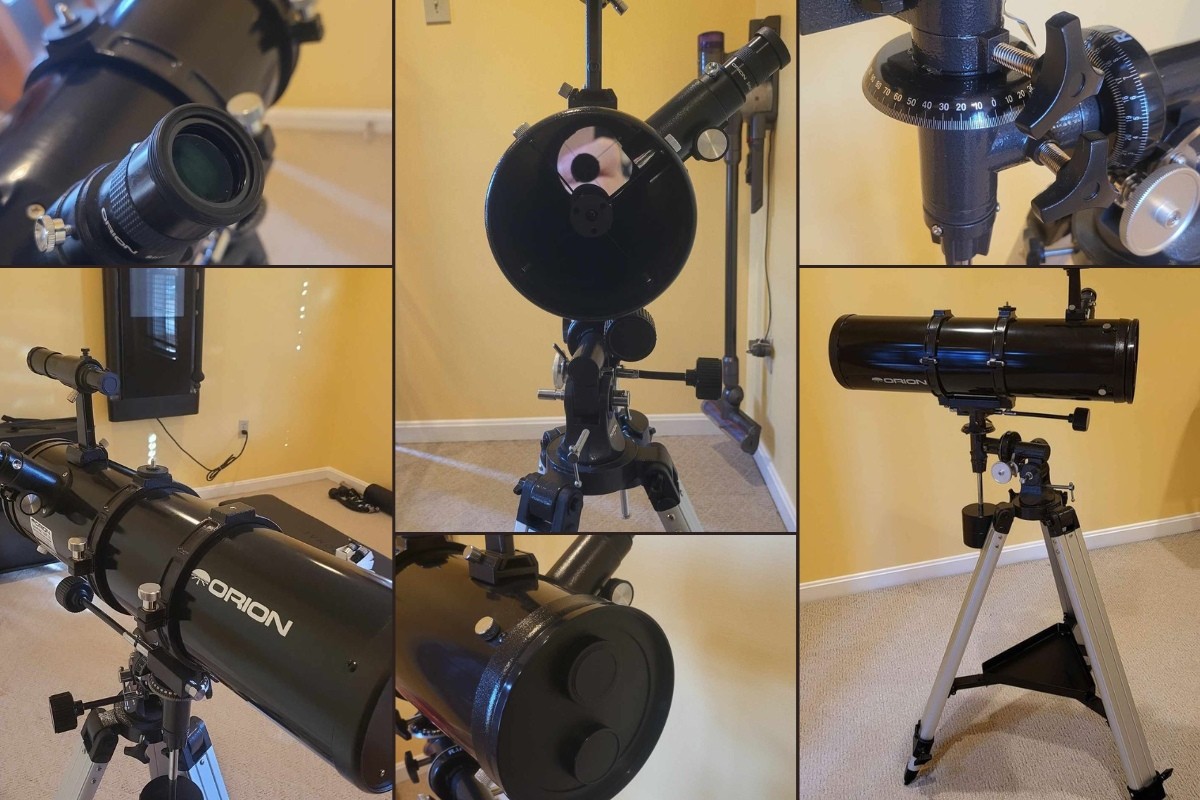


hi, what is your Rating about this one?
Updated.
Hi – I am looking at buying a second hand telescope. Locally, I can choose between this and an AWB Onesky. Would you recommend one over the other?
I’d personally get the SpaceProbe. As much as I love the OneSky it has a really low-quality helical focuser and the requirement for a table is kind of annoying.
I am thinking of getting this scope, but I feel the focuser and mount would limit me in the future and the former would be difficult to get a good replacement for. Would you recommend another 5″ f5 reflector over this one?
I would recommend the Zhumell Z130, Celestron Astro-Fi 130, or AWB OneSky instead.
currently have a tasco 60mm refracting toy. looking to upgrade to either a starblast 4.5 or spaceprobe 130st. budget is a considertation but not a hard stop. I live in the suburbs so any serious observation will require travel. is the increase in aperture significant enought when observing planets or galaxies?
If you want to look at galaxies an 8″ or larger Dob is really what you need, and is easier to use.
I am thinking of buying either the SpaceProbe 130slt or Meade Polaris 130. You said that the SpaceProbe is overpriced. How much would you reduce its price, so it had a reasonable value for money? Does this scope have any important qualities that the Meade Polaris lacks? And which one would You recommend if the value for money does not play the main role, but is not completely neglected?
Thank You.
The 130ST has a sturdier mount, better optical quality and better eyepieces than the Polaris 130. However, a 6″ or 8″ Dob is vastly superior to either.
Comparing the pictures of the Orion SpaceProbe 130ST and AstroView 6 EQ both in their reviews on this site and their current pictures in Orion’s store, it looks like they both used to use the same older EQ2 mount with the square legs, and now currently both use the same ‘updated’ EQ2 mount with round legs.
Given your comments in the updated astroview 6 review about how terrible that new mount is in comparison to the old one, how badly do you think that would affect the lighter spaceprobe 130st? Do you think the spaceprobe would still be a decent scope?
The SpaceProbe is still pretty much the same sturdiness-wise.
I would like for you to update this page. I own the telescope, and I believe the mount has gotten a lot better. The tripod is now preassembled and using steel circular legs, and can be used by shorter people (5 foot) with the tripod being retracted. The eq-13 mount is actually very good, wobbles were only a problem when I found plato’s craterlets at 130x and 180x. The 10mm is pretty meh, but the 25mm is extremely sharp. collimation is easy, and the screws can be turned by hand. There is also no longer a plate on the back of the mirror.
I’m debating to go with this or the more cost effecient Orion star Blast EQ 2. I have a 70mm travel scope and want to upgrade and actually see more stars and depth.
The StarBlast is a little smaller but the mount is a lot steadier
Looks like Orion read this review and changed the mount to a Dovetail bracket.
I picked up one of these on Facebook marketplace for $100 as a first time telescope for me and my 12 year old son to use together. Do you have any updates for additional eye pieces or other accessories I should buy to maximize it’s abilities, based on currently available market?
Hi there, I’d recommend a good low-power eyepiece like a 24mm UFF, and a high-power eyepiece like a 9mm Redline + a good Barlow or a 3-4mm eyepiece. Also the Celestron motor drive fits this to give you hands-free tracking.